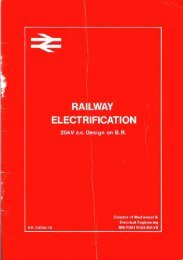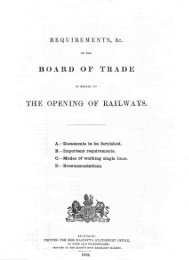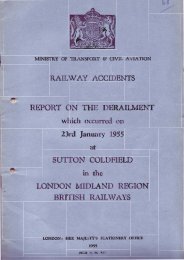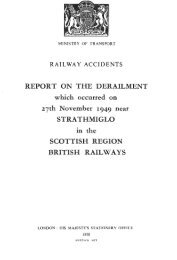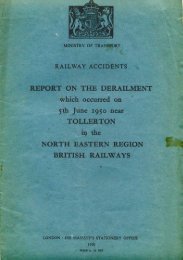R A I LT R AC K - The Railways Archive
R A I LT R AC K - The Railways Archive
R A I LT R AC K - The Railways Archive
Create successful ePaper yourself
Turn your PDF publications into a flip-book with our unique Google optimized e-Paper software.
6.8 6.9<br />
6.8 Timetabling<br />
With an increasing demand for use of the network, we must<br />
ensure that the existing,and future, capacity is efficiently<br />
allocated through an effective timetabling process.<strong>The</strong> Rail<br />
Regulator has recently approved our proposals for change to<br />
Access Condition D which governs this.<br />
With the development of the May 2000 timetable<br />
planned for this year, we move away from the potentially<br />
combative bid and offer process where train operators’bids<br />
are kept secret until the last minute . In the past this gave us a<br />
limited window to assess the implications for identifying<br />
optimal solutions and the true performance impact of<br />
options available.<br />
Instead, we will move towards a more collaborative<br />
approach starting with a National Train Planning Conference<br />
which will operate along the lines of the International Air<br />
Transport Association airline-slot allocation meeting.Over a<br />
period of three-days,train operators will discuss with us their<br />
aspirations for the following year.We have also developed a<br />
code of practice detailing the mechanism for the handling of<br />
requests for access rights prior to the commencement of the<br />
timetabling process.<br />
At the Conference, all of our Zones will be<br />
represented.We plan to convene multi-Zone line of route<br />
discussions with train operators in order that we can identify,<br />
at a very ear ly stage, likely ‘hot spots’.<strong>The</strong> teams will then<br />
jointly develop a plan to produce a fully operable ‘draft’<br />
timetable over the following 14 weeks.At agreed milestone<br />
dates, we will present standard-hour models to demonstrate<br />
how the development work is progressing.In the case of<br />
new services,this will be accompanied by appropriate results<br />
from network congestion models.<br />
This new collaborative approach will enable operational<br />
planning teams to develop a range of timetabling options<br />
rather than the present one solution,offering more optimal<br />
paths and potentially reduced journey times including the<br />
impact of scheduled engineering work on the availability of<br />
the network for train services and assesses the true<br />
performance impact of the whole timetable package. Our<br />
aim will be to minimise both the impact of engineering work<br />
on our customers services and minimise the performance<br />
risk of the timetable. During the 14-week drafting stage, our<br />
Area Delivery Groups will be involved in reviewing the<br />
timetable options,and account teams in agreeing with<br />
customers commercial terms for any new access rights.<br />
6.9 Investment packages<br />
How this Plan is structured to meet industry<br />
vision and needs<br />
<strong>The</strong> ten-year plan set out in this Statement is structured to<br />
meet our vision,and that of our customers,funders and<br />
other partners.It provides a bold agenda to deliver step<br />
changes in the capacity and capability of the network.It sets<br />
out our funding assumptions,and provides a summary of the<br />
main schemes which we propose. More details of the<br />
schemes,and how they have been set within the context of<br />
customer-reasonable requirements and the Route Strategies,<br />
are then set out in the route sections of this document.<br />
Risk and return<br />
As part of his current periodic review, the Regulator has<br />
provided a challenge to Railtrack to indicate not only<br />
what we believe the right strategic plans are for developing<br />
the industry, but also how we could share more of the<br />
demand risk involved.We welcome this opportunity.This<br />
Network Development Plan sets out our proposals in the<br />
investment area.<br />
All investments involve various types of risk.<br />
• Construction risk – the risk that the costs of the project<br />
will exceed the budget and/or forecast completion date.<br />
• Counter-party risk – the risk that the party funding the<br />
project will not be able to meet its obligations for<br />
reasons not related to the project.<br />
• Functionality risk – the risk that,even though completed,<br />
the investment is incapable of delivering its intended<br />
outputs.<br />
• Demand risk – risk that the demand generated by the<br />
project will not meet forecast levels.<br />
• Regulatory risk – risk as to how the investment will be<br />
treated by the Rail Regulator at future reviews of access<br />
charges.<br />
We will move<br />
towards a more<br />
collaborative<br />
approach starting<br />
with a National Train<br />
Planning Conference<br />
73



